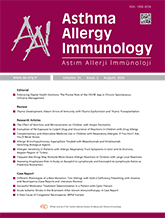


Objective: This study aimed to investigate the basophil-to-lymphocyte ratio (BLR) and eosinophil-to-lymphocyte ratio (ELR) as potential predictive biomarkers for anaphylaxis risk.
Materials and Methods: A cross-sectional study was conducted involving 66 anaphylaxis patients, 70 chronic spontaneous urticaria patients, and 65 healthy individuals. Data on demographics, clinical history, and laboratory results were collected from electronic medical records. BLR and ELR were calculated. The predictive values of BLR and ELR were evaluated using receiver operating characteristic (ROC) analysis.
Results: Significant differences were found in basophil and eosinophil counts among the groups with median BLR values of 0.03 (0.01), 0.02 (0.01), and 0.03 (0.01), and mean ELR values of 0.07 (0.06), 0.05 ± 0.03, and 0.06 (0.01) for groups 1 (anaphylaxis), 2 (chronic spontaneous urticaria), and 3 (healthy control) respectively. BLR comparisons between Group 1 and Groups 2 and 3 yielded p-values of <0.001 and 0.002, respectively. ELR comparisons also showed statistical significance, with p-values of <0.001 and 0.001. Multivariate binary logistic regression revealed BLR and ELR as independent predictors of anaphylaxis, with area under the curve (AUC) values of 0.69 and 0.72, respectively, indicating modest predictive capacity.
Conclusion: BLR and ELR present a novel avenue in assessing patients at risk for anaphylaxis. Despite their modest predictive value, these ratios could potentially be used as adjunctive tools in clinical evaluations. Further large-scale studies are needed to validate these findings and to explore their potential therapeutic implications.